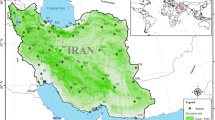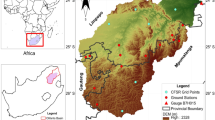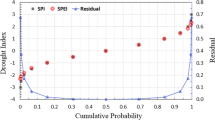Abstract
Drought is a well-known yet incredibly difficult to understand hydro-meteorological natural hazard that occurs around the globe as a result of major climate change occurrences. For the central Gujarat region, we examined the drought periodicities during the previous 30 years for this study. The patterns of drought conditions are a sign of climatic and environmental change, and recognizing these trends is crucial for the sustainable management of water resources. Application of the MK test to the first SPI series revealed that the post-monsoon SPI series had a negligible upward trend. The MK test on the original SPEI series indicated several time series with large declining trends prior to the monsoon, whereas every post-monsoon SPEI series displayed an insignificant growing trend. The findings demonstrate that (1) due to the various time series, the SPI and SPEI's identification of the characteristics of drought were quite distinct in space at various timescales, (2) The SPI and SPEI differed most at the shortest time scale, and (3) The drought represented by the two indicators may be consistent over long periods of time. (4) The SPEI may be more suitable than the SPI for drought monitoring in the study region when compared to typical drought occurrence. It should be emphasized that future research will need to examine whether the SPI and SPEI's adaptability varies among regions and historical periods.
Access this chapter
Tax calculation will be finalised at checkout
Purchases are for personal use only
Similar content being viewed by others
References
Afshar MH, Bulut B, Duzenli E, Amjad M, Yilmaz MT (2022) Global spatiotemporal consistency between meteorological and soil moisture drought indices. Agric for Meteorol 316:108848
Agarwal S, Suchithra AS, Singh SP (2021) Analysis and interpretation of rainfall trend using Mann-Kendall’s and Sen’s slope method. Indian J. Ecol 48:453–457
Ali R, Kuriqi A, Abubaker S, Kisi O (2019) Long-term trends and seasonality detection of the observed flow in Yangtze River using Mann-Kendall and Sen’s innovative trend method. Water 11(9):1855
Araghi A, Baygi MM, Adamowski J, Malard J, Nalley D, Hasheminia SM (2015) Using wavelet transforms to estimate surface temperature trends and dominant periodicities in Iran based on gridded reanalysis data. Atmos Res 155:52–72
Asadi Zarch MA, Sivakumar B, Sharma A (2015) Droughts in a warming climate: a global assessment of standardized precipitation index (SPI) and reconnaissance drought index (RDI). J Hydrol 526:183–195
Bera B, Shit PK, Sengupta N, Saha S, Bhattacharjee S (2021) Trends and variability of drought in the extended part of Chhota Nagpur plateau (Singbhum Protocontinent), India applying SPI and SPEI indices. Environ Challs 5:100310
Das S, Ghosh A, Hazra S, Ghosh T, de Campos RS, Samanta S (2020) Linking IPCC AR4 & AR5 frameworks for assessing vulnerability and risk to climate change in the Indian Bengal Delta. Prog Disaster Sci 7:100110
Dogan NO (2018) Bland-Altman analysis: a paradigm to understand correlation and agreement. Turk J Emerg Med 18(4):139–141
Fung KF, Huang YF, Koo CH (2019) Coupling fuzzy–SVR and boosting–SVR models with wavelet decomposition for meteorological drought prediction. Environ Earth Sci 78(24):1–18
Ghasemi P, Karbasi M, Nouri AZ, Tabrizi MS, Azamathulla HM (2021) Application of Gaussian process regression to forecast multi-step ahead SPEI drought index. Alex Eng J 60(6):5375–5392
Guttmann NB (1999) Accepting the standardized precipitation index: a calculation algorithm 1. J Am Water Resour Assoc 35(2):311–322
He Y, Ye J, Yang X (2015) Analysis of the spatio-temporal patterns of dry and wet conditions in the Huai River Basin using the standardized precipitation index. Atmos Res 166:120–128
Jain SK, Kumar V, Saharia M (2013) Analysis of rainfall and temperature trends in northeast India. Int J Climatol 33(4):968–978
Joshi S, Li Y, Kalwani RM, Gold JI (2016) Relationships between pupil diameter and neuronal activity in the locus coeruleus, colliculi, and cingulate cortex. Neuron 89(1):221–234
Krishnamurthy PK, Lewis K, Choularton RJ (2014) A methodological framework for rapidly assessing the impacts of climate risk on national-level food security through a vulnerability index. Glob Environ Chang 25:121–132
Kumar KN, Rajeevan M, Pai DS, Srivastava AK, Preethi B (2013) On the observed variability of monsoon droughts over India. Weather Clim Extrem 1:42–50
Labat D (2005) Recent advances in wavelet analyses: Part 1. A review of concepts. J Hydrol, 314 (1–4), 275–288.
Luhaim ZB, Tan ML, Tangang F, Zulkafli Z, Chun KP, Yusop Z, Yaseen ZM (2021) Drought variability and characteristics in the muda river basin of Malaysia from 1985 to 2019. Atmosphere 12(9):1210
Mallick J, Talukdar S, Alsubih M, Salam R, Ahmed M, Kahla NB, Shamimuzzaman M (2021) Analysing the trend of rainfall in Asir region of Saudi Arabia using the family of Mann-Kendall tests, innovative trend analysis, and detrended fluctuation analysis. Theoret Appl Climatol 143(1):823–841
Mckee TBT, Doesken NJNJ, Kleist J (1993) The relationship of drought frequency and duration to time scales. Eighth conference on applied climatology, 17(22). Am Meteorol Soc, Boston, pp 179–183
Menna BY, Mesfin HS, Gebrekidan AG, Siyum ZG, Tegene MT (2022) Meteorological drought analysis using copula theory for the case of upper Tekeze river basin, Northern Ethiopia. Theor Appl Climatol, 1–18
Mishra AK, Singh VP (2010) A review of drought concepts. J Hydrol 391(1–2):202–216
Mundetia N, Sharma D (2015) Analysis of rainfall and drought in Rajasthan State. India. Glob NEST J 17(1):12–21
Nikhil Raj PP, Azeez PA (2012) Trend analysis of rainfall in Bharathapuzha river basin, Kerala. India. Int J Climatol 32(4):533–539
Ojha SS, Singh V, Roshni T (2021) Comparison of meteorological drought using SPI and SPEI. Civ Eng J 7(12):2130–2149
Onoz B, Bayazit M (2003) The power of statistical tests for trend detection. Turk J Eng Environ Sci 27(4):247–251
Pande CB, Costache R, Sammen SS et al (2023a) Combination of data-driven models and best subset regression for predicting the standardized precipitation index (SPI) at the Upper Godavari Basin in India. Theor Appl Climatol 152:535–558. https://doi.org/10.1007/s00704-023-04426-z
Pande CB, Kushwaha NL, Orimoloye IR et al (2023b) Comparative assessment of improved SVM method under different Kernel functions for predicting multi-scale drought index. Water Resour Manage 37:1367–1399. https://doi.org/10.1007/s11269-023-03440-0
Paras H, Sanjay P, Vaibhav R (2022) The significance impact assessment of morphological parameters on watershed: a review. Agric Rev 43(1):110–115
Partal T (2010) Wavelet transform-based analysis of periodicities and trends of Sakarya basin (Turkey) streamflow data. River Res Appl 26(6):695–711
Qaisrani ZN, Nuthammachot N, Techato K (2021) Drought monitoring based on standardized precipitation index and standardized precipitation evapotranspiration index in the arid zone of Balochistan province. Pakistan. Arab J Geosci 14(1):1–13
Rashed M, Idris Y, Shaban M (2015) Integrative approach of GIS and remote sensing to represent the hydrogeological and hydro chemical conditions of Wadi Qena Egypt. In the 2nd International Conference On Water Resources And Arid Environment, Saudi Arabia. pp 26–29
Salehnia N, Ahn J (2022) Modelling and reconstructing tree ring growth index with climate variables through artificial intelligence and statistical methods. Ecol Ind 134:108496
Tefera AS, Ayoade JO, Bello NJ (2019) Comparative analyses of SPI and SPEI as drought assessment tools in Tigray Region. Northern Ethiopia. SN Applied Sciences 1(10):1–14
Tirivarombo S, Osupile D, Eliasson P (2018) Drought monitoring and analysis: Standardized Precipitation Evapotranspiration Index (SPEI) and Standardized Precipitation Index (SPI). Phys Chem Earth Parts 106:1–10
Vicente-Serrano SM, Beguería S, López-Moreno JI (2010) A multiscalar drought index sensitive to global warming: the standardized precipitation evapotranspiration index. J Clim 23(7):1696–1718
Wang N, Lu C (2009) Two-dimensional continuous wavelet analysis and its application to meteorological data. J Atmos Oceanic Tech 27(4):652–666
Wang W, Zhu Y, Xu R, Liu J (2014) Drought severity change in China during 1961–2012 indicated by SPI and SPEI. Nat Hazards 75(3):2437–2451
World Meteorological Organization (2012) Standardized Precipitation Index User Guide. Svoboda, M., Hayes, M., & Wood, D, Geneva
Yang P, **a J, Zhan C, Zhang Y, Hu S (2018) Discrete wavelet transform-based investigation into the variability of standardized precipitation index in Northwest China during 1960–2014. Theoret Appl Climatol 132(1–2):167–180
Yerdelen C, Abdelkader M, Eris E (2021) Assessment of drought in SPI series using continuous wavelet analysis for Gediz Basin. Turkey. Atmospheric Research 260:105687
Yue S, Pilon P, Phinney B, Cavadias G (2002) The influence of autocorrelation on the ability to detect trend in hydrological series. Hydrol Process 16(9):1807–1829
Author information
Authors and Affiliations
Corresponding author
Editor information
Editors and Affiliations
Rights and permissions
Copyright information
© 2023 The Author(s), under exclusive license to Springer Nature Switzerland AG
About this chapter
Cite this chapter
Hirapara, P., Brahmbhatt, M., Tiwari, M.K. (2023). Investigation of Trends and Variability Associated with the SPI and SPEI as a Drought Prediction Tools in Gujarat Regions, India. In: Pande, C.B., Kumar, M., Kushwaha, N.L. (eds) Surface and Groundwater Resources Development and Management in Semi-arid Region. Springer Hydrogeology. Springer, Cham. https://doi.org/10.1007/978-3-031-29394-8_5
Download citation
DOI: https://doi.org/10.1007/978-3-031-29394-8_5
Published:
Publisher Name: Springer, Cham
Print ISBN: 978-3-031-29393-1
Online ISBN: 978-3-031-29394-8
eBook Packages: Earth and Environmental ScienceEarth and Environmental Science (R0)




